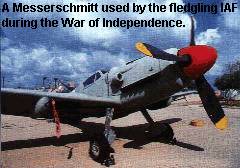The Avia S.199 was a Czech version of the Messerschmitt Bf 109G-14 manufactured at previously German-controlled factories from the Messerschmitt blueprints. The standard airframe was combined with the only available engine, the Jumo 211F, and so the result differed from the original German design by having a larger engine cowling. The plane had difficult handling characteristics, especially during takeoff and landing and very unforgiving controls, reasons for which it earned the nickname “mule.” Having the most rudimentary of air forces upon its creation, Israel was hard pressed for air power and so bought 25 examples of the type in early 1948. Pilot training commenced at the beginning of May when 12 pilots, including Ezer Weizman, current president of Israel, were dispatched to Czechoslovakia. On May 15, however, the creation of the state of Israel was declared and with it came the Arab invasion that began the War of Independence. The pilots demanded to return to Israel despite having very little flight training and no weapons training, and on May 20, 1948, a C-54 Skymaster containing the first S.199 landed at Tel-Nof AFB. The first weeks of fighting had not gone well for the newly born Israel Defense Forces, with an Egyptian armored column progressing on Tel-Aviv and threatening to destroy the newly born state, while enemy aircraft roamed the skies unchallenged, bombing Israeli cities. And so it was that on the evening of May 29, with four assembled planes and another five in various stages of completion, that Israel's first fighter squadron first went into action. Four S.199s took off from Tel-Nof, where the fighters were based, to attack the Egyptian forces headed for Tel-Aviv. The fighters descended on the surprised Egyptians and began to bomb and strafe them but one crashed before completing his mission. Despite losing a valuable fighter, the attack had achieved its goal — although inflicting very little damage and a small number of casualties, it had a great psychological effect which halted the enemy's advance and allowed ground forces to organize and go on the offensive. Within days, the newly arrived fighters had participated in attacks on all fronts and were instrumental in pushing back the invading Arab armies. With another S.199 lost a day after the first attack, they were more valuable in what they represented than in the actual damage they inflicted — the appearance of an Israeli fighter arm was a complete surprise to Arab commanders and also a great morale boost to the local population. It was on June 3 that the citizens of the young state learned of the existence of a local fighter force, with the first aerial victories of the Israeli Air Force. Expecting very little resistence from the ground, two Egyptian Dakotas appeared over Tel-Aviv on the evening of June 3. After dropping their bombing loads they began making their way home when they were pounced upon by a lone S.199 piloted by Moddy Alon, Israel's first fighter squadron leader. Both bombers were shot down, signaling an end to Arab domination of the air. The Avia S.199s continued to serve as fronting fighters with the IAF until the end of the war, first from the airfield at Herzlia and later from Hazor AFB, although attrition had taken a great toll on them — toward the end of 1948, of the 25 originally purchased, 12 had been lost, seven were in different stages of repairs and only six were fully operational.
Sources: IAF Inventory |
